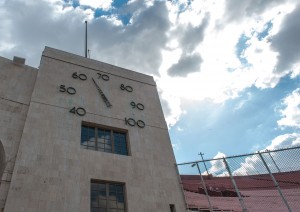Viterbi students finish project repairing thermometer
Viterbi School of Engineering students will complete the process of repairing the Los Angeles Memorial Coliseum’s famous thermometer, which has been stuck at 70 degrees for more than a few decades.

Heatwave · The thermometer in the Los Angeles Memorial Coliseum was mostly fixed by undergraduate Viterbi engineering students in November. The students created spare parts and an instruction manual. – William Ehart | Daily Trojan
A group of 30 engineering classes proposed a bid for the revitalization with an initial budget of $300. Each class was responsible for one aspect of the project. Meanwhile, professional bids had projected construction costs to be between $5,000 and $10,000.
David Cape, a senior majoring in mechanical engineering and a member of the Spirit of Troy drum line, spent long days playing on the field of the Coliseum. He witnessed the stagnant thermometer that always read 70 degrees. For more than 30 years, the thermometer in the Coliseum did not move.
The thermometer was installed in 1955 on the east end of the Coliseum.
Cape and his team members Charlie Palmer, Andrew Ezarik and Ryan Magruder created a prototype under budget at $280. Out of the three final teams, this foursome won and was given $1,000 to, as Cape described, “beef up the system.”
The final design was voted and chosen by a group of professors, including Yann Staelens and Charles Radovich, in association with the Los Angeles Coliseum Commission and Los Angeles Coliseum Commission representatives.
These improvements included polishing, fixing minor problems, and installing a backup battery that resets to 70 degrees automatically when the power goes out or is turned off.
The project was tedious, as team members dedicated lab time and free time to create the best possible solution for the historic venue. The four-member team had a final product ready for the last home football game in November 2012, but still continued to finalize their design by outlining the process of repairing the themometer in the future.
The backup battery system was installed in December and the final manual that outlined repair methods was completed two weeks ago. Now, the team focuses on creating spare parts in case of future repairs after their graduation.
Cape felt the process offered real world experience like that they would face after graduation.
“It felt very much like we were a company,” Cape said. “We were stumbling across trying to make it, do everything within a budget within a ridiculous time.”
Ezarik viewed the project as more than a project, but an opportunity for a legacy.
“It was cool to leave a mark on the school or leave somewhat of a legacy behind — to be part of a real engineering project, with real client, a tight deadline, and small budget,” Ezarik said.
For future generations of Trojans and Coliseum fans alike, the thermometer will stand not just as a measure of the weather, but as a reminder of the work that students with a passion can achieve.
“It was eye opening,” Cape said. “This is what I am going to be doing in real life, having a job and dealing with all the little things you have to think about.”
